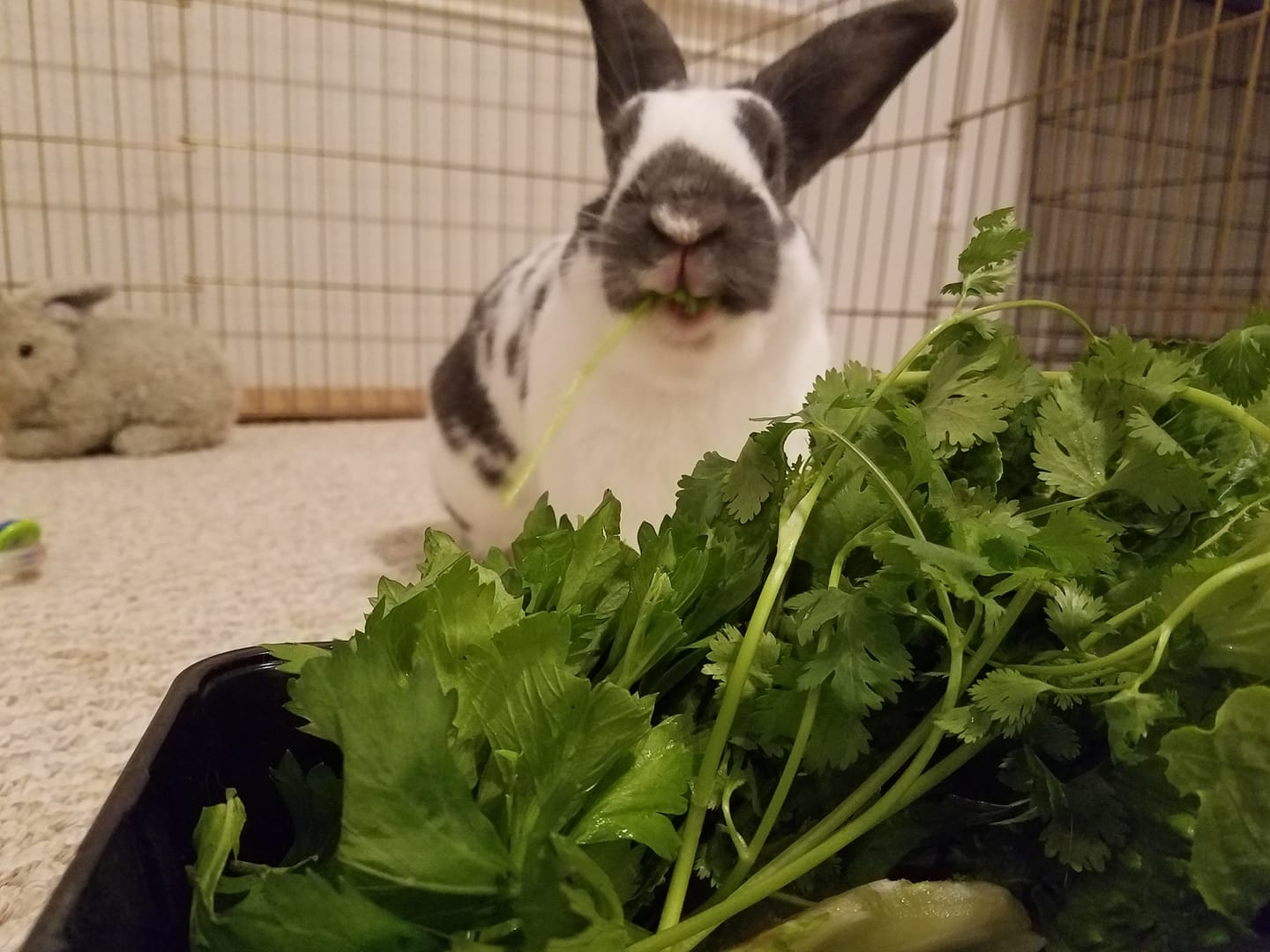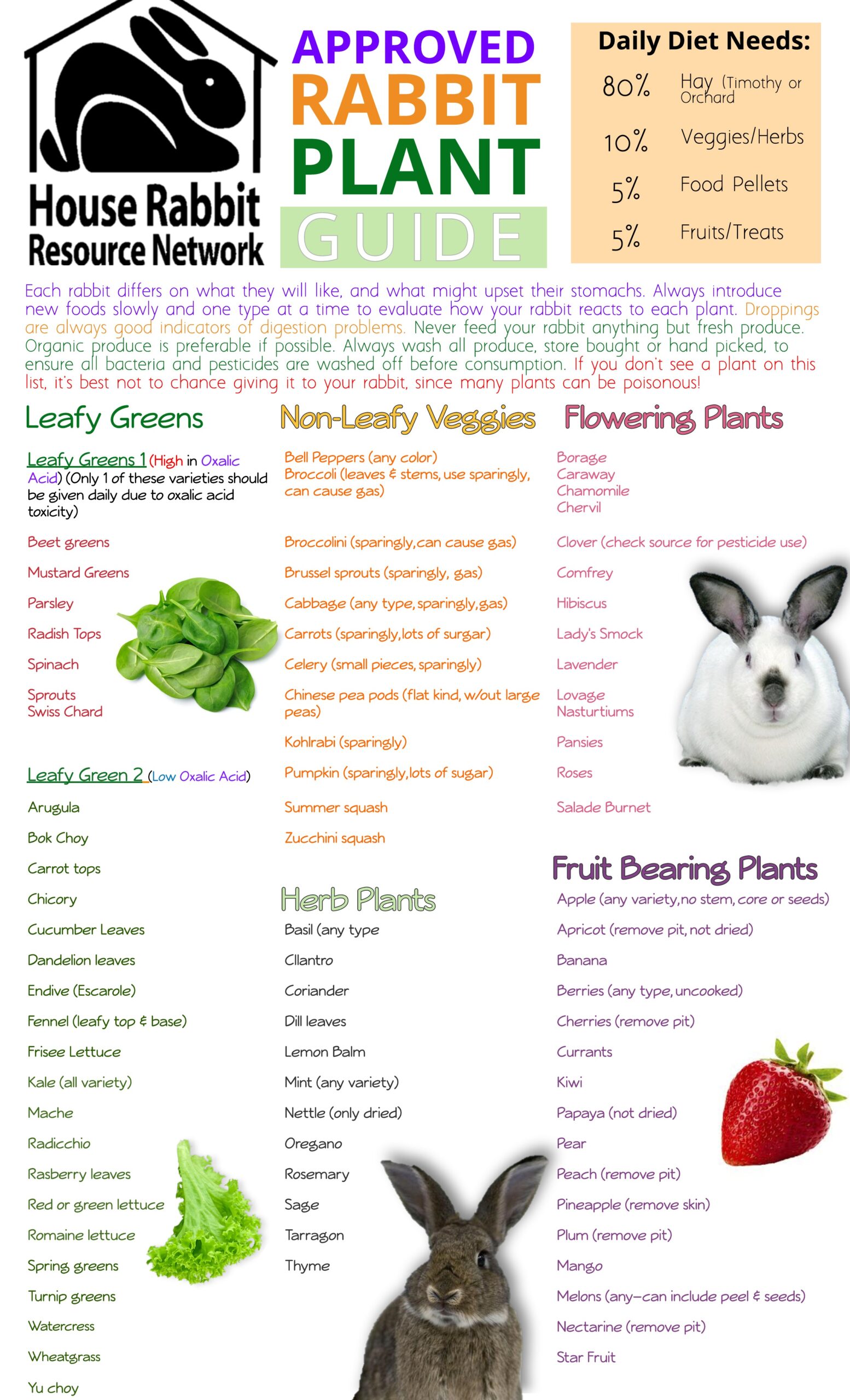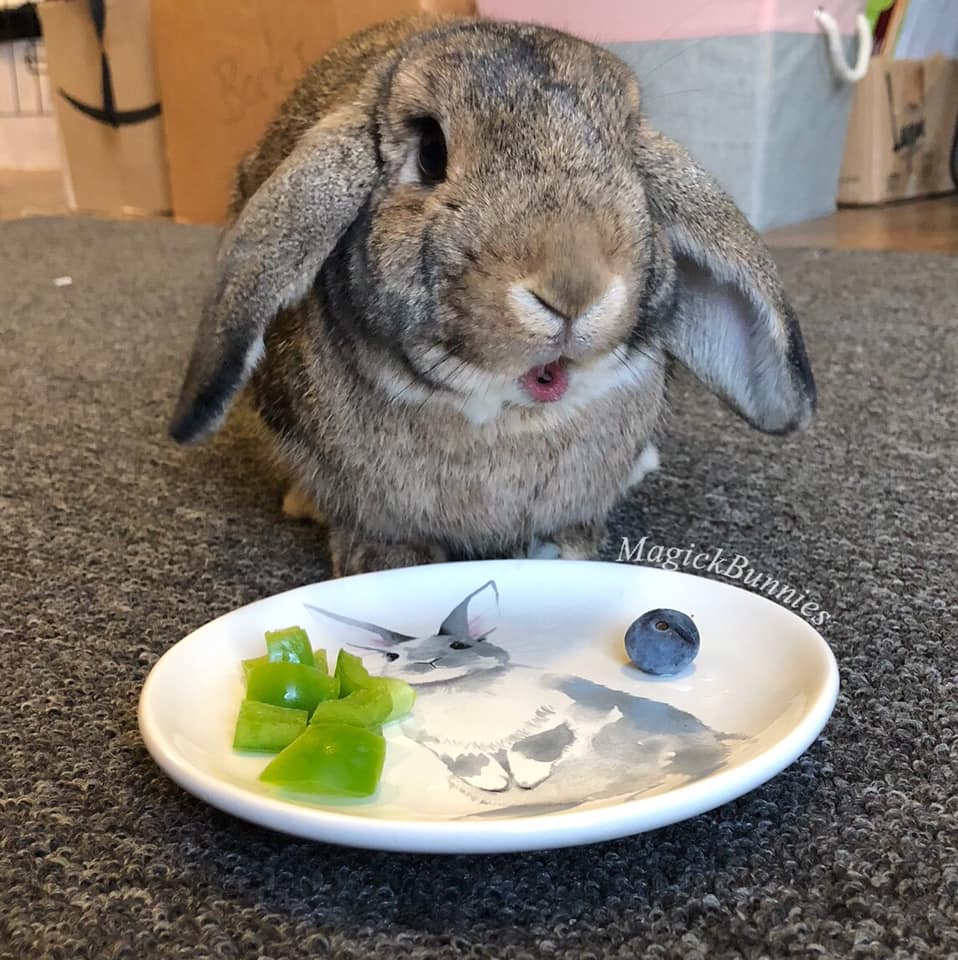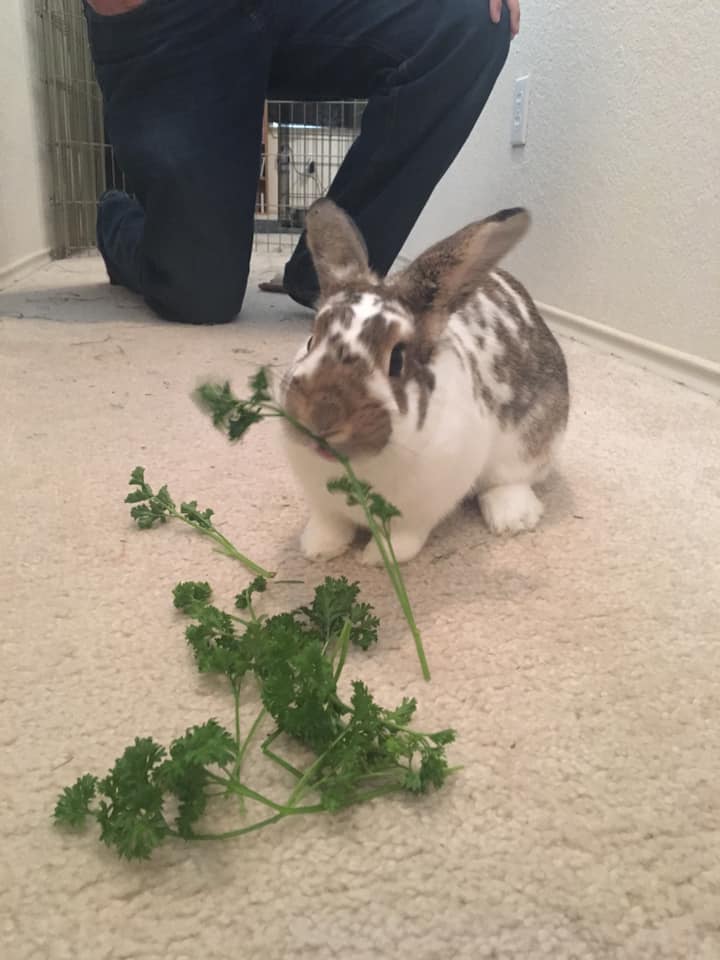Fresh Foods Information
for Your rabbit
Fresh foods make up an important part of your rabbit’s diet; they provide additional nutrients, water, as well as different textures and tastes, which are enriching for your rabbit-friend. Fresh foods for rabbits consist of a variety of leafy greens, non-leafy vegetables, herbs, and fruit.
10% of your rabbits diet should be from fresh foods.
Fresh Foods for Rabbits
Overview
Fresh foods are an important part of your rabbit’s diet; they provide additional nutrients as well as different textures and tastes, which are enriching for your rabbit-friend.
Fresh foods also provide more moisture in the diet, which is good for kidney and bladder function. The majority of fresh foods given to your rabbit should be made up of leafy greens (between a cup or two cups of leafy greens per bunny a day). Give starchy vegetables (e.g. carrots) in moderation (even though classified as vegetables, they contain a lot of sugar), and use bits of fruit only in very, very small quantities, as special treats. Too much sugar and starch can cause cecal dysbiosis, and all its associated problems.
Be sure to wash everything thoroughly to remove pesticide and fertilizer residues. Even organic produce should be washed well to remove potentially harmful bacteria, such as E. coli. Serve the vegetables wet, as this will help increase your rabbit’s intake of liquid. This helps keep the intestinal contents moving well, and your bunny healthy.
Please don’t make the mistake of serving less-than-fresh vegetables to your rabbit. A rabbit is even more sensitive to spoiled food than humans. If the vegetables smell stale or “on the fringe”, they could make your bunny sick. Follow the Emerald Rule of Freshness when feeding your rabbit friend: “Don’t Feed it to Your Bunny if You Wouldn’t Eat It Yourself.”
Fresh Foods for Rabbits
Vegetables
Not All Veggies are Created Equal
Rabbits are sensitive creatures both emotionally and physically; that is why knowing which vegetables and fruits are safe for your rabbit to consume is so important.
There is a very common misconception that rabbit’s can live off carrots, carrots, and more carrots. That could not be any further from the truth! Carrots are very high in sugar and can cause severe problems if fed too much. Like candy, small amounts of carrots can be fed as a nice treat.
Leafy greens are going to be your main focus when finding good, appetizing veggies to feed your rabbit. About 10% of your rabbit’s diet should be comprised of vegetables, mainly of the leafy green category. But, even in the leafy greens category, not all vegetables are safe for your rabbit.

Fresh Foods for Rabbits
Types of Vegetables
The Good, the Bad, and the "Eh, Okay"
We recommend you print or save this list of veggies for your rabbit. Hang it on your fridge, in your office, or have it in your phone for when you go grocery shopping.
You want to know about the good veggies (those Low in Oxalic Acid, herbs and some flowering plants), the ones that are okay, but that should be fed in moderation (those high in Oxalic Acid, non-leafy greens, and fruit), and the ones that are absolutely dangerous, toxic, and should never be fed to your rabbit.
Below this list is more in depth information about the different categories of veggies for your rabbit. To learn about each category, click on the links below:
What is Oxalic Acid?
You’ll notice the Leafy Greens portion of the Fresh Foods for Rabbits Approved Plants List is broken up into 2 Categories: Those leafy greens that are HIGH in Oxalic Acid, and those that are LOW in Oxalic Acid.
Oxalic acid is an organic compound found in many plants, including leafy greens, vegetables, fruits, cocoa, nuts and seeds.
In plants, Oxalic Acid is usually bound to minerals, forming oxalate. The terms “oxalic acid” and “oxalate” are used interchangeably in nutrition science.
Oxalates are found in almost all plants, but some plants contain very high amounts while others have very little–this is where we divide up the Leafy Greens list into high and low oxalate categories, to prevent possible Oxalate Toxicity in your rabbit.
When consumed in small quantities, oxalates are harmless to both animals and humans. The problems with Oxalate Toxicity occur when you feed too many plants in the High Oxalic Acid category too often. It’s a build up over time thing.
Most house rabbit experts recommend either fully avoiding the Leafy Greens 1 category (just to be on the safe side), or limiting consumption to three times a week or less. Remember, each rabbit is different, some rabbits will be more sensitive to oxalates than others, so you’ll need to make the judgment about feeding from this category based on your rabbit and how they react to this group of plants.
“Food containing high levels of oxalates should be avoided to help minimize the formation of calcium oxalate stones (kidney stones). These include spinach, parsley, celery and strawberries. Rabbits on a diet that is too high in calcium might accumulate a calcium-rich “sludge” in the bladder. This occurs in rabbits fed alfalfa hay and spinach, both high in calcium. This sludge causes chronic discomfort and irritation.” – Rabbits, Bacteria and Calcium Dr. Carl Palazzolo, DVM, DEC 27 2016.
There is a group of rabbit-savvy veterinarians and bunny experts who recommend feeding at least 3 different types of leafy greens per day, with one of those three being from the high oxalate category while the other two from the low, while rotating the vegetables for “variety”. However, at House Rabbit Resource Network we have actually steered away from this line of thinking based on our personal experiences. We are more of the thinking to avoid Leafy Greens category 1 plants entirely, as we’ve just seen so many rabbits experience digestive upsets when given even small quantities from the Leafy Green 1 category. We also no longer recommend rotating the types of veggies, because we’ve found that, more often than not, it causes gut issues in the rabbits. We recommend finding the veggies that are in the Leafy Greens category 2 that work for your rabbit and sticking with them (Ex: Romaine Lettuce with some Endive mixed in). This has shown to drastically lower the cases of gut stasis, gas build up, and sludge issues in our shelter rabbits and adopted rabbits.
Leafy Greens 1
High in Oxalic Acid
- Spinach
- Parsley
- Mustard Greens
- Beet Greens
- Radish Tops
- Sprouts
- Swiss Chard
The Leafy Greens that are in this category are known to contain high amounts of Oxalic Acid. This is the vegetable group that you will want to either avoid feeding altogether, or feed in moderation (many experts say 3 times a week or less, but HRRN feels even that is a bit too often. We recommend 2 times a week or less, but everyone’s rabbit will tolerate this food group differently, so adjust based on your experience.
The reason behind the caution with this group of vegetable is because if you feed too much or too regularly from this food group, it can cause Oxalate Toxicity and potentially kill your bunny.
Sadly, there are too many stories out there from amateur bunny caretakers who thought feeding their bunny spinach everyday was healthy for them, only to find their rabbit dead one day for no apparent reason. Oxalate Toxicity builds up, so your rabbit will probably be fine for awhile, until they are not.
Leafy Greens 2
Low in Oxalic Acid
- Arugula
- Bok Choy
- Carrot Tops
- Chicory
- Cucumber Leaves
- Dandelion Leaves
- Endive (Escarole)
- Fennel (Leafy Top & Base)
- Frisee Lettuce
- Kale (all variety)
- Mache
- Radicchio
- Raspberry Leaves
- Red or Green Lettuce
- Romaine Lettuce
- Spring Greens
- Turnip Greens
- Watercress
- Wheatgrass
- Yu choy
This should be the main group from which you feed your rabbit. Low in Oxalic Acid, this vegetable group offers delicious, nutrient rich goodness for your rabbit.
Many rabbit experts recommend feeding your rabbit a variety of greens from this category at each feeding, and then rotating through the list for variety sake.
For example: a mix of romaine and carrot tops with some kale sprinkled around on Monday, Wednesday, and Friday, then feeding Arugula, Red Lettuce, and Watercress on the other days of the week. Some even go as far as to say then switch that variety up from week to week. Obviously, for many rabbits this has been a fine recommendation. However, House Rabbit Resource Network has steered away from this line of thinking based on our personal experience. Meaning, we’re not saying the other way is wrong, but through our own plethora of experiences, we have found this way of rotating a variety of greens to cause more problems than benefits. We see those rabbits who are fed a variety of greens that are constantly getting switched up and around to have more instances of gut stasis, gas, and sludge issues. Because of this personal experience by many of our veteran bunny caretakers, we recommend for our adopters to find one to three types of leafy greens from this category and stick with them. For Example: Romaine Lettuce with Carrot Tops and Arugula for every fresh foods feeding.
Non-Leafy Green Vegetables
- Bell Peppers
- Broccoli (leaves & stems, use sparingly, can cause excess gas)
- Broccolini (sparingly, can cause excess gas)
- Brussel Sprouts (sparingly, gas)
- Carrots (sparingly, LOTS of sugar)
- Celery (sparingly, gas and oxalates)
- Chinese pea pods (flat kind, w/out large peas)
- Kohlrabi (sparingly, gas)
- Pumpkin (sparingly, lots of sugar)
- Summer squash
- Zucchini squash
While non-leafy green vegetables do not have the threat of oxalate toxicity, several of these types have a tendency to cause gas, and therefore cause a build up in painful gas that can become life-threatening if not handled correctly.
If slowly introduced and fed in small quantities, any gas your rabbit may experience won’t be large enough to cause a problem. But, if your rabbit has too much they can begin having a painful buildup of gas in their intestines which turns into Gastrointestinal Stasis (Gut Stasis or GI Stasis).
HRRN Alumni Frey has a light snack of bell peppers and one blueberry. This is a great example of feeding non-leafy green foods in moderation. Just enough to add some fun into Frey’s diet, but it’s a small enough amount to most likely not cause any gastrointestinal issues. Frey and his partner Marigold have their own Instagram! Follow them at @magickbunnies
Herbs & Flowering Plants
Herbs and Flowering Plants are a great way to add a little “zest” to your rabbit’s diet safely. Most do not cause G.I distress and they do not contain oxalates. But remember to introduce any new plant to your rabbit slowly, and don’t change it up too much day to day.
Herbs
Flowering Plants
- Basil
- Cilantro
- Coriander
- Dill Leaves
- Lemon Balm
- Mint
- Nettle (Only Dried)
- Oregano
- Rosemary
- Sage
- Tarragon
- Thyme
- Borage
- Caraway
- Chamomile
- Chervil
- Clover (check source for pesticide use)
- Comfrey
- Hibiscus
- Lady’s Smock
- Lovage
- Nasturtiums
- Pansies
- Roses
- Salade Burnet
Fruits/Treats
- Apple (any variety, no stem, core or seeds)
- Apricot (remove pit, not dried, added sugar)
- Banana (small slices)
- Berries (any type, uncooked)
- Cherries (remove pit)
- Currants
- Kiwi
- Papaya (not dried, added sugar)
- Pear
- Peach (remove pit)
- Pineapple (remove skin)
- Plum (remove pit)
- Mango
- Melons (can include peel & seeds)
- Nectarine (remove pit)
- Star Fruit
Fruits are incredibly high in simple sugars and carbohydrates, which are not good for your rabbits gut microbiome health.
Treats can consist of fruit (which HRRN recommends) or man-made items. If you want a treat for your bunny other than fruit, we recommend baking the treats yourself, so you know exactly what is in the treat. Here are some good, easy baked treats for your bunny.
Fruits/Treats are one of those foodstuffs that are fine in small amounts. They are great to be used as treats.
5% of a rabbit’s diet can be fruit/treats—that’s not very much. An 1/8th of a banana, 1 large strawberry, etc. is adequate for your rabbit a day or every few days.
Remember, in the wild, rabbit’s would rarely run into fruit, and if they did, it would not be an everyday occurrence. That’s why at House Rabbit Resource Network, we advise to only use fruit as a treat, because it’s essentially like giving your child a piece of candy, which you wouldn’t do every day.
If your rabbit accidentally eats a lot of fruit in one sitting somehow, call your rabbit-savvy vet immediately.
The Absolute No-No's
While there are varying degrees of good and not so good vegetables and fruits for rabbits, there are some absolute, never, ever, nope-nopity-nope, foods that you should be aware of to never feed your rabbit.
Apple Seeds
Cabbage
Chocolate
Corn
Cauliflower
Iceberg Lettuce
Peach, apricot, nectarine pits
Potato or peels
Rhubarb
Anything too old to eat yourself
If your rabbit has ingested anything on this list, contact your veterinarian immediately.



